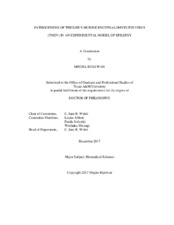| dc.description.abstract | Epilepsy is a complex neurological disease composed of two or more unprovoked seizures that occur due to aberrant neuronal hyperexcitability. Detailed analysis of the mechanisms involved in epilepsy is required since there is a lack of adequate preventive therapies and one third of epileptic patients are pharmaco-resistant. Theiler’s murine encephalomyelitis virus (TMEV) infection induces a well-characterized experimental model of epilepsy. In response to intracerebral (I.C.) injection of DA or BeAn strain of TMEV in C57BL/6 mice, there is an unregulated immune response that has detrimental effects on neurons, and contributes to acute seizures, rendering mice susceptible to epilepsy. However, the specific contributions of virus and innate immune components to epileptogenesis need to be elucidated. For the first objective, we compared the in vivo neurovirulence of two variants of the DA strain, small (DA-DS) and large (DA-CL) plaque forming variants, by infecting C57BL/6 mice IC with either DA-DS or DA-CL variant. For the latter two objectives, we investigated the function of Nlrc5 and Nlrc3 genes as positive or negative regulator of anti-viral immunity and epilepsy by infecting age-matched C57BL/6 wild type, Nlrc5^-/- , and Nlrc3^-/- mice with BeAn strain of TMEV. The infected mice were monitored for seizures, sickness, weight loss, and cognitive and behavioral deficits during the course of infection. Brains and spinal cords from infected mice were collected to determine viral titers, histopathology, and characterization of cellular infiltration.
We identified that DA-DS-infected mice exhibited significantly more seizures, sickness behavior, anxiety, weight loss, viral burden, neuroinflammation, and neuronal damage than DA-CL- infected mice. Thus, DA-DS variant was found highly neurovirulent, while DA-CL variant was attenuated in epilepsy.
With respect to NLRs we found that Nlrc5^-/- infected mice had significantly fewer seizures, lower sickness scores, weight loss and neuroinflammation, than wild type mice. In contrast, Nlrc3^-/- infected mice were found hypersusceptible to acute seizures, epilepsy, and anxiolytic behavior. Furthermore, we determined that chronic seizures were not the consequence of persistent inflammation. We infer that Nlrc5 significantly upregulated anti-viral inflammation and seizures, while Nlrc3 significantly downregulated acute seizures and chronic epilepsy in C57BL/6 mice. | en |


